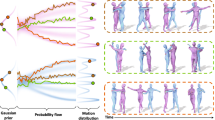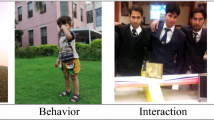Abstract
This paper aims at investigating the relationship between gestures’ expressivity and the amount of attention they attract. We present a technique for quantifying behavior saliency, here understood as the capacity to capture one’s attention, by the rarity of selected motion and gestural expressive features. This rarity index is based on the real-time computation of the occurrence probability of expressive motion features numerical values. Hence, the time instants that correspond to rare unusual dynamic patterns of an expressive feature are singled out. In a multi-user scenario, the rarity index highlights the person in a group which shows the most different behavior with respect to the others. In a mono-user scenario, the rarity index highlights when the expressive content of a gesture changes. Those methods can be considered as preliminary steps toward context-aware expressive gesture analysis. This work has been partly carried out in the framework of the eNTERFACE 2008 workshop (Paris, France, August 2008) and is partially supported by the EU ICT SAME Project (www.sameproject.eu) and by the NUMEDIART Project (www.numediart.org).
Similar content being viewed by others
References
Berlyne DE, Berlyne DE (1974) Studies in the new experimental aesthetics
Boiman O, Irani M (2007) Detecting irregularities in images and in video. Int J Comput Vis 74(1):17–31
Bruce NDB, Tsotsos JK (2009) Saliency, attention, and visual search: An information theoretic approach. J Vis 9(3):5
Camurri A, Lagerlöf I, Volpe G (2003) Recognizing emotion from dance movement: Comparison of spectator recognition and automated techniques. Int J Hum Comput Stud Elsevier Sci 59:213–225
Camurri A, Volpe G, De Poli G, Leman M (2005) Communicating expressiveness and affect in multimodal interactive systems. IEEE Multimed 43–53
Cowan N (2001) The magical number 4 in short-term memory: A reconsideration of mental storage capacity. Behav Brain Sci 24(01):87–114
Cowie R, Douglas-Cowie E, Tsapatsoulis N, Votsis G, Kollias S, Fellenz W, Taylor JG (2001) Emotion recognition in human-computer interaction. IEEE Signal Process Mag 18(1):32–80
Dhavale N, Itti L (2003) Saliency-based multifoveated MPEG compression. In: Signal processing and its applications, 2003. Proceedings. Seventh international symposium on, vol 1
Eastwood JD, Smilek D, Merikle PM (2001) Differential attentional guidance by unattended faces expressing positive and negative emotion. Percept Psychophys 63(6):1004–1013
eNTERFACE 2008. http://enterface08.limsi.fr/
Glowinski D, Bracco F, Chiorri C, Atkinson A, Coletta P, Camurri A (2008) An investigation of the minimal visual cues required to recognize emotions from human upper-body movements. In: Proceedings of ACM international conference on multimodal interfaces (ICMI), workshop on affective interaction in natural environments (AFFINE). ACM, New York
Hatfield E, Cacioppo JT, Rapson RL (1994) Emotional contagion studies in emotion and social interaction. Editions de la Maison des sciences de l’homme
Itti L, Baldi P (2006) Bayesian surprise attracts human attention. Adv Neural Inf Process Syst 18:547
Kurtenbach G, Hulteen EA (1992) Gestures in human-computer communication. In: The art of human-computer interface design, pp 309–317
Le Meur O, Le Callet P, Barba D, Thoreau D (2006) A coherent computational approach to model bottom-up visual attention. IEEE Trans Pattern Anal Mach Intell, pp 802–817
Liu F, Gleicher M (2006) Video retargeting: automating pan and scan. In: Proceedings of the 14th annual ACM international conference on multimedia. ACM, New York, pp 241–250
Mancas M (2007) Computational attention: Towards attentive computers. Similar edition. CIACO University Distributors
Mancas M (2009) Relative influence of bottom-up and top-down attention. In: Attention in cognitive systems. Lecture notes in computer science, vol 5395/2009. Springer, Berlin, pp 212–226
Mancas M, Gosselin B, Macq B (2007) A three-level computational attention model. In: Proc of ICVS workshop on computational attention & applications, Germany
Mancas M, Mancas-Thillou C, Gosselin B, Macq B (2007) A rarity-based visual attention map-application to texture description. In: Proceedings of IEEE international conference on image processing, pp 445–448
Mehrabian A, Russell JA (1974) An approach to environmental psychology
Parkhurst DJ, Niebur E (2004) Texture contrast attracts overt visual attention in natural scenes. Eur J Neurosci 19(3):783–789
Picard RW (1997) Affective computing. MIT Press, Cambridge
Stormark KM, Hugdahl K, Posner MI (1999) Emotional modulation of attention orienting: A classical conditioning study. Scand J Psychol 40(2):91–99
Velastin SA, Lo BA, Vicencio-Silva BPLJS (2005) PRISMATICA: toward ambient intelligence in public transport environments. IEEE Trans Syst Man Cybern, Part A 35(1):164–182
Vuilleumier P, Armony J, Dolan R (2003) Reciprocal links between emotion and attention. In: Friston KJ, Frith CD, Dolan RJ, Price C, Ashburner J, Penny W, Zeki S, Frackowiak RSJ (eds) Human brain functions. Academic Press, San Diego, pp 419–444
Wallbott HG (1998) Bodily expression of emotion. Eur J Soc Psychol 28:879–896
Watson D, Clark LA, Tellegen A (1988) Development and validation of brief measures of positive and negative affect: The PANAS scales. J Pers Soc Psychol 54(6):1063–1070
Yee H, Pattanaik S, Greenberg DP (2001) Spatiotemporal sensitivity and visual attention for efficient rendering of dynamic environments. ACM Trans Graph (TOG) 20(1):39–65
Zhang S, Stentiford F (2007) Motion detection using a model of visual attention. In: Image processing, 2007. ICIP 2007. IEEE international conference on, vol 3
Author information
Authors and Affiliations
Corresponding author
Additional information
Portions of this work were presented in “Proceedings of eNTERFACE’08”.
Rights and permissions
About this article
Cite this article
Mancas, M., Glowinski, D., Volpe, G. et al. Real-time motion attention and expressive gesture interfaces. J Multimodal User Interfaces 2, 187 (2008). https://doi.org/10.1007/s12193-009-0017-5
Received:
Accepted:
Published:
DOI: https://doi.org/10.1007/s12193-009-0017-5




